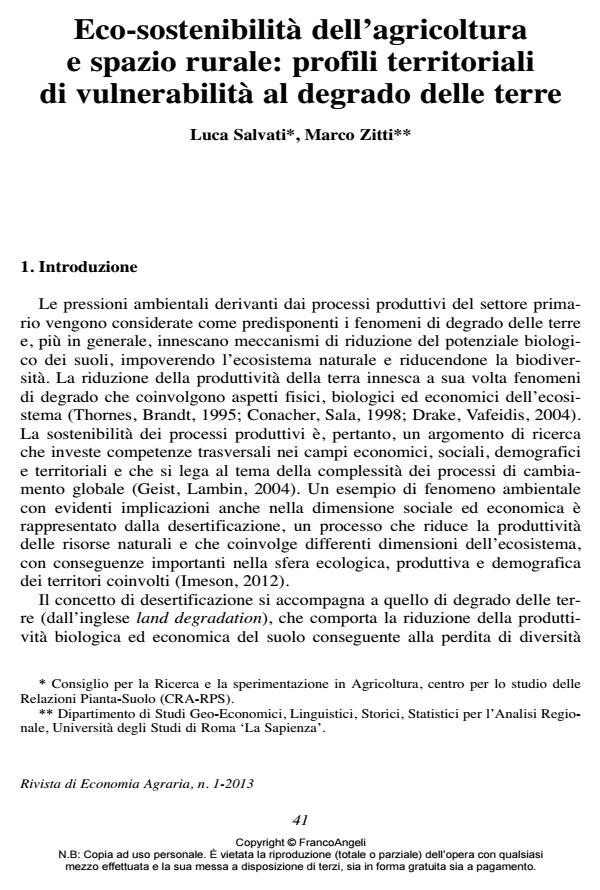The sustainability of agriculture and rural spaces: profiling areas with different vulnerability to land degradation
Journal title RIVISTA DI ECONOMIA AGRARIA
Author/s Luca Salvati, Marco Zitti
Publishing Year 2013 Issue 2013/1
Language Italian Pages 20 P. 41-60 File size 652 KB
DOI 10.3280/REA2013-001003
DOI is like a bar code for intellectual property: to have more infomation
click here
Below, you can see the article first page
If you want to buy this article in PDF format, you can do it, following the instructions to buy download credits

FrancoAngeli is member of Publishers International Linking Association, Inc (PILA), a not-for-profit association which run the CrossRef service enabling links to and from online scholarly content.
Drought, land degradation, and desertification are global problems which involve different climatic, soil, vegetation, agricultural and demographic factors. Originally attributed to the most arid regions of the world, the risk of desertification has rapidly increased in temperate regions. In Mediterranean Europe, high human pressure, climatic changes, and intensive agriculture development has combined to produce land consumption, a key factor in starting desertification processes. Unfortunately, the effect of agriculture on land degradation has been poorly considered as far as quantitative indicators and cartographic tools are concerned. The aim of this paper is to introduce a system of agro-environmental indicators aimed at improving a model for desertification risk assessment, especially focusing on land quality, farm management and the impact of agricultural practices. Based on a multivariate exploratory strategy including non-hierarchical cluster analysis and linear discriminant analysis, thirty-two indicators have been included in an Environmentally Sensitive Area (ESA) application to define the contribution of agriculture to land sensitivity in the Region of Lazio (Latium), Italy. Finally, new findings achieved in the context of the agricultural impact on the environment have been discussed as an original contribution to the study of desertification.
Nell’Europa Mediterranea la pressione demografica unita alle variazioni climatiche e ad uno sviluppo agricolo a tratti intensivo hanno contribuito al degrado del territorio rurale che risulta così più esposto al rischio di desertificazione. Dal punto di vista del monitoraggio, tale fenomeno non ha ancora avuto una sistematizzazione adeguata, nonostante i numerosi approcci proposti, tra cui spicca il modello ESA (Environmentally Sensitive Areas), che rappresenta ad oggi uno standard condiviso a livello internazionale anche se criticato in alcune sue componenti. L’obiettivo di questo lavoro è proporre un sistema di indicatori ed una metodologia di analisi integrata che possano contribuire al monitoraggio permanente del livello di vulnerabilità degli spazi rurali ai fenomeni di degrado delle terre superando i limiti intrinseci del modello ESA. L’approccio ha previsto l’identificazione di 32 indicatori derivanti da fonti censuarie su cui è stata applicata una strategia esplorativa basata su analisi dei gruppi, al fine di individuare partizioni territoriali omogenee in termini di vulnerabilità. Le variabili maggiormente significative nel determinare tali gruppi sono state identificate mediante analisi discriminante. La classificazione territoriale così ottenuta è stata verificata attraverso confronto con tre indici di vulnerabilità indipendenti. La metodica è stata applicata a livello comunale nella regione Lazio ed ha individuato nelle variabili di intensificazione dell’agricoltura e di uso insostenibile delle risorse naturali a scala locale gli indicatori che maggiormente caratterizzano i comuni classificati come vulnerabili, posti lungo la costa e nelle pianure interne. I risultati proposti consentono di discutere il contributo degli indicatori agro-ambientali nello studio del rischio di desertificazione nel Mediterraneo.
Keywords: Exploratory multivariate analysis, local scale, agro-environmental indicators, vulnerability, desertification, mediterranean basin
Jel codes: Q010, Q240, Q300, Q570, R140
Luca Salvati, Marco Zitti, Eco-sostenibilità dell’agricoltura e spazio rurale: profili territoriali di vulnerabilità al degrado delle terre in "RIVISTA DI ECONOMIA AGRARIA" 1/2013, pp 41-60, DOI: 10.3280/REA2013-001003